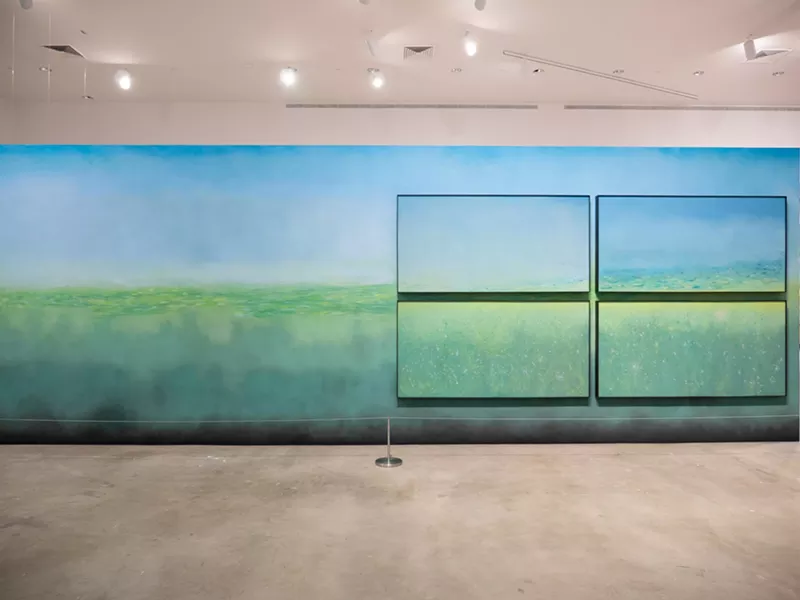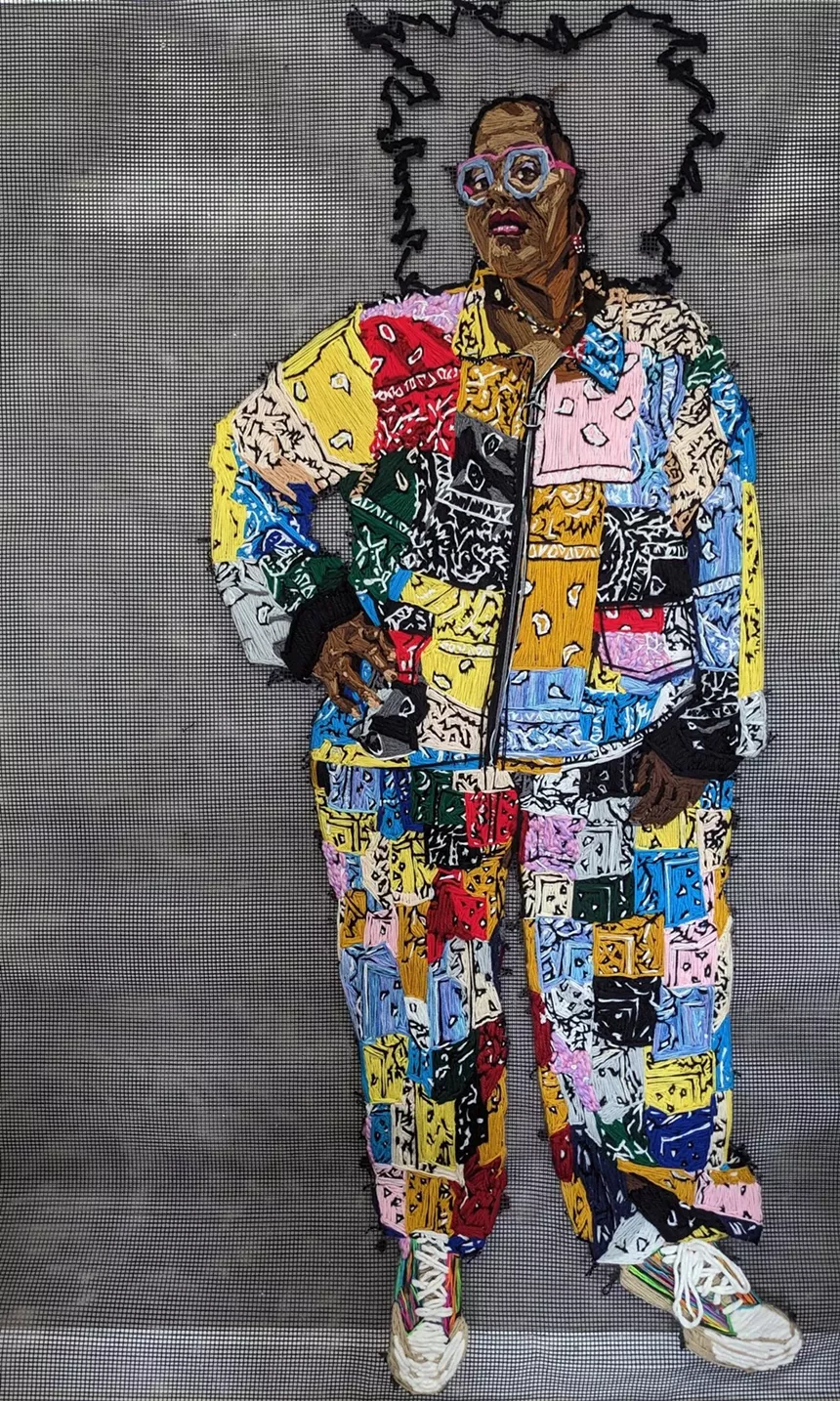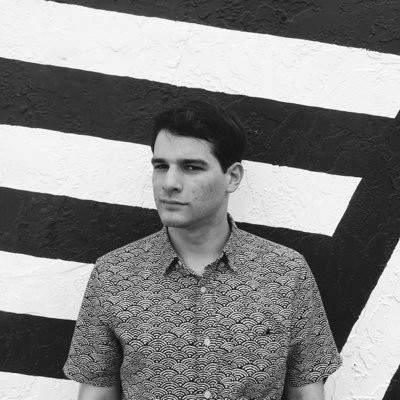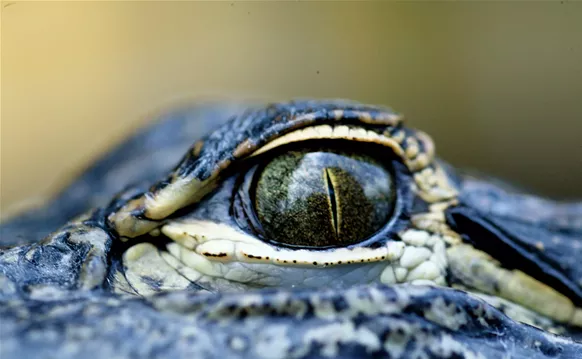"Future Past Perfect," which the museum terms as seven concurrent individual exhibits, features impressive, stylistically diverse work from a group of local artists worth monitoring. Many were able to refine their skills during the pandemic, according to Bonnie Clearwater, the museum's director and chief curator.
"They did have so much time to concentrate, really focus on their work without distractions. So there was this development beyond their years," she says.
Clearwater feels the show is evidence of the South Florida scene's increasing investment in the arts and that the region is reaping the benefits of more institutions and better resources. "There is an infrastructure that has depth now that is supporting it from Miami to Palm Beach," she says. She's also been able to watch several of the artists in "Future Past Perfect" evolve and develop this style firsthand.
"Zoe Schweiger, her parents met at [the Museum of Contemporary Arts, North Miami]," she recalls. "Her first art class was when she was 5 years old at MOCA. I've known Lulu Sanchez since her mother was carrying her when she was pregnant."
Because "Future Past Perfect" is seven individual presentations in one, New Times has laid out a short review for each artist below. Dive in, and don't miss the show before it closes on October 15.

Alejandro Piñeiro Bello's Mariposas
Photo by Zachary Balber/Courtesy of the artist and KDR305/© Alejandro Piñeiro Bello
Alejandro Piñeiro Bello, "Escaping Paradise"
Hands down, the best presentation out of the seven is at the front of the museum's top-floor gallery. Measuring a massive 12 by 19 feet, Exodus is an acid trip of a painting, as immersive and grand as it is otherworldly and terrifying. Palm trees melt, heads float disembodied in the water, and bright colors pulse with a nightmarish iridescence. Dalí is the obvious comparison to make, but the work would be nothing without the Cuban artist's own inspiration, drawn from his time stranded on the island after the outbreak of the pandemic disrupted a family trip. Fauvist colors recur across his work, especially in the still life Mariposas, which recalls Izumi Kato's recent color experiments, while the totemic Hura-Kan, showing the brawny spiral of a tropical storm, appears godlike and unsettling. The work feels deeply embedded in and resonant with the subtropical way of life and all its travails: intense heat, political reactivity, frequent brushes with death by hurricanes, and rising tide. Piñeiro Bello may have been thinking of Cuba, but his work could just as easily be about Florida, a place that increasingly feels less like paradise and more like somewhere from which to escape.Nathalie Alfonso, "LineScape Dusk"
Piñeiro Bello's painting isn't the only purpose-made work on display, but at least it'll still exist after the exhibition ends. The same can't be said for Nathalie Alfonso's site-specific work "LineScape Dusk," a mural executed in pastels that takes up an entire temporary wall at the front of the show space. That wall is coming down at the end of the show, and the painting is going with it. The work is all about the fleetingness and fragility around us; its pastoral vista a direct reference to Monet's Water Lilies, clearly depicts the Everglades, and any self-respecting Floridian should get the message. If we're not careful, the beautiful, grand ecosystem just outside our sprawling cities will crumble along with those pretty pastel blues and greens.Kandy G. Lopez, "(In)visibility: Caché"
While artists like Kehinde Wiley and Amoako Boafo have become stars for their intricate, art history-referencing portraits of ordinary and extraordinary Black folks (not without resistance), here Kandy G. Lopez offers another, simpler take on the popular genre through fabric instead of paint. The NSU professor's work features embroidered portraits of regular people in street clothes. Rather than Wiley's bold colors and Baroque-style backgrounds, Lopez features her subjects against blank backgrounds or within the cityscapes they already inhabit, colored in beiges and grays that make the subjects stand out. They have "caché," according to the wall text, an inner power that is self-evident and needs no embellishing.Susan Kim Alvarez, "Oogly Boogly"
There's a certain amount of cartoonish, Adventure Time-style whimsy to Susan Kim Alvarez's surreal, maximalist paintings. Certainly, her work contains the iconic animated show's tonal shifts, from macabre and gross to funny and charming, often in the same work, along with a certain amount of smeary, Ren and Stimpy grotesqueness. They feel indebted to that 2010s era of creator-driven animation, where series such as Regular Show felt like a high-schooler's doodles come to life, and Over the Garden Wall and Cuphead resurrected the ghosts of American animation's early, weird era. But Alvarez's personality gives the work an extra flair, both in her sense of humor — one particularly messy painting is titled That time I threw up trying to play tennis — and in imaginative explorations of her unique Cuban, Vietnamese, and Jewish heritage, such as the monstrous, Cheshire Cat-faced guardian lion in My mom called it a cloaca. Some paintings are more abstract, such as the two spacey paintings in the back where Alvarez's line-drawn characters appear in outline against dreamlike backgrounds of ocean blue and galactic black. Others feel like Where's Waldo books, full of humorous details, including references to other artists in the show. There are also works in other mediums, such as a felt painting of a weird little guy courting another, weirder little guy with the awkward title Wanna Go on a Date?Zoe Schweiger, "Above the Limestone"
Looks can be deceiving. Try not to get too enamored by Schweiger's floaty, effuse portraits of fair young women, for instance: You're staring into an abyss. In a commentary on climate change unique for both allure and terror, the Miami native's paintings depict a future Florida where her friends and lovers, including her friend and fellow artist Susan Kim Alvarez, are submerged and floating in an underwater realm that we may yet inherit. Faces are obscure, bodies blurred and amorphous. Angry reds, oranges, and browns dominate, the bright Florida sun turning the world into an inescapable oven. I'm reminded of Shelley Winters' watery grave in The Night of the Hunter and of Cecily Brown, celebrated for her similarly fluidic, fleshy paintings and feminist lens on art history. Schweiger's siren-like figures recall Brown paintings such as Black Painting 4 at the Rubell Museum, itself a riff on Goya's famous mythological horrors. Instead of beckoning us to our own doom, these sirens function more as a warning: If we keep our present course, we'll all go down with the ship.Lulu Sanchez, "Adolfoland"
While Schweiger may be looking to the future with her work, Lulu Sanchez's debut exhibition aims to fuse the present with the past, specifically the downtown New York of the 1980s. The oft-mythologized milieu of Basquiat and Talking Heads was also where her uncle, Adolfo Rene Sanchez, set much of his life and work before dying tragically young in 1990, a victim of the AIDS epidemic. Artists like Richard Prince and Jeff Koons gained massive fame by lifting images from corporate ads; Adolfo also used the technique, taking from Latin cultural phenomena like Mexican fotonovelas. Instead, Sanchez appropriates her uncle's pop-influenced style to "collaborate" with him from beyond the grave. In one image, she paints her own portrait and that of her friends in the brightly colored club environment Adolfo inhabited. In another, she turns an image her uncle appropriated into a touching family portrait. It's personal artwork that reflects on a rarely-told truth: AIDS may have taken many famous artists, but it also took many more who weren't. They deserve to be remembered, too.Joel Gaitan, "Muerto Por Una Traición"
Finally, it's an amusing coincidence that Joel Gaitan's wild, chonga-fied take on ancient Mesoamerican ceramics is on display at the same time as a show of Picasso ceramics. The contrast between the Spanish artist's stately, Mediterranean pottery of animals and odalisques and the Nicaraguan-America's ribald terracotta creations, which seem to play with ideas around anthropological voyeurism directed at indigenous peoples, is great. The devil is in the details: What looks like regular Mayan idols are decorated with intricate gold embellishments, some campier than others. One statue resembling an Olmec head features a huge, gilded nose ring and gravity-defying braids. One clay pot wears Louis Vuitton earrings; nearby, a bare-breasted idol's snakelike necklace plunges down her cleavage as she bares a garish gold grill in her smiling mouth. Then there's the runway-like altar these characters rest upon, painted in Miami Dolphins teal-and-orange. Imagine future archaeologists digging these up –—what kind of stories would they come up with?"Future Past Perfect." On view through October 15 at NSU Art Museum, 1 E. Las Olas Blvd., Fort Lauderdale; 954-525-5500; nsuartmuseum.org. Tickets cost $5 to $16; free for members and children under 12. Tuesday through Saturday 11 a.m. to 5 p.m., and Sunday noon to 5 p.m.












